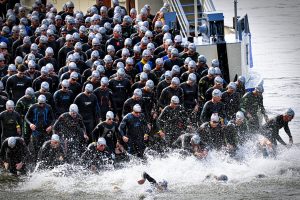Off-road training
Off-road training is an exciting and challenging way to prepare for triathlons, especially if you’re tackling an Xterra or off-road triathlon. Unlike road-based events, off-road triathlons add layers of complexity, with rugged trails, unpredictable terrain, and diverse elevation changes. Training for these unique conditions helps build strength, agility, and mental resilience, all essential for handling off-road courses.
This post explores the key elements of off-road training for biking and trail-running, offering practical tips to improve your skills, build strength, and adapt to unpredictable surfaces.
Benefits of Off-Road Training
Training off-road isn’t just for those racing off-road events—it has benefits that can enhance overall fitness and versatility for any triathlete. Running on trails and mountain biking increases lower body strength, improves balance, and trains your body to adapt to uneven terrain. Off-road training can also reduce the repetitive impact stress common on roads, making it a great option for active recovery and injury prevention.
Benefits Include:
- Improved Balance and Coordination: Uneven surfaces require constant adjustments, engaging stabilizing muscles and improving coordination.
- Increased Strength and Endurance: Hills, rocks, and roots demand power and agility, helping build both muscular strength and endurance.
- Mental Fortitude: Off-road courses can be mentally taxing, teaching resilience and quick decision-making skills.
- Reduced Impact on Joints: Softer surfaces like dirt or grass can decrease the impact forces on your knees and ankles, providing a joint-friendly alternative to pavement.
Whether your goal is a rugged Xterra race or simply becoming a stronger, more resilient athlete, incorporating off-road elements in your training will prepare you for any challenge.
1. Off-Road Bike Training
Mountain biking (MTB) is the cornerstone of off-road triathlons. Training off-road requires technique, endurance, and strength, especially when navigating steep climbs, rough descents, and sharp turns.
Key Skills to Develop:
- Body Position: Uphills, downhills, and turns all require different body positions. Practice keeping a low center of gravity and shifting your weight to adapt to terrain.
- Braking Technique: Use both front and rear brakes wisely to control speed without skidding. Avoid sudden braking and practice using brakes gradually.
- Cornering Skills: Take turns by leaning your bike rather than your body, which will help you maintain control on sharp corners and slippery trails.
- Descending Skills: On descents, position yourself over the back of the saddle and keep your arms relaxed to absorb impact. This stance maximizes stability.
Sample Off-Road Bike Training Plan:
- Skill Sessions: Spend time working on technical skills, such as cornering, braking, and maneuvering around obstacles. Practice on trails with different levels of difficulty.
- Hill Repeats: Hill climbing is an essential skill. Find a hilly trail or MTB course and do hill repeats to build power, focusing on controlled climbs and quick descents.
- Endurance Rides: Off-road endurance rides build stamina. Ride for 60–90 minutes on mixed terrain, including technical sections and open trails. This combination trains both endurance and technical skill.
- Interval Training: For strength and power, include intervals such as 5 x 3 minutes on challenging terrain with 2-minute recoveries. Repeat the intervals on a climb or technical section to simulate race conditions.
2. Off-Road / Trail Running Training
Trail running is quite different from road running, emphasizing balance, agility, and reactive strength. It challenges you to stay alert and adaptable while navigating rocks, roots, and uneven surfaces. Trail running prepares you for unpredictable terrain and strengthens muscles that aren’t typically engaged on flat surfaces.
Key Skills to Develop:
- Foot Placement: Off-road terrain demands strategic foot placement. Focus on looking ahead to avoid obstacles and adjust each step.
- Pacing Control: Trail running usually involves varied pace due to terrain. Learn to adjust your pace quickly depending on incline and obstacles.
- Uphill and Downhill Running: Uphills require strength and controlled breathing, while downhills demand focus and balance. Practice staying light on your feet to reduce impact.
- Adaptability: Unlike road running, trails require constant awareness and adjustments. Running drills that emphasize agility and quick changes in direction are excellent for trail preparedness.
Sample Off-Road Run Training Plan:
- Short Trail Runs: Begin with short, 20–30 minute runs on beginner trails. Gradually increase distance and difficulty as you get more comfortable with technical terrain.
- Hill Workouts: Uphill sprints (6–8 reps of 30 seconds uphill with a walk back) build leg strength and cardiovascular endurance. Practice staying light and quick with each step.
- Long Trail Runs: Long, steady-paced runs improve endurance. Pick a course with varied terrain and run at a moderate pace, paying attention to form and agility.
- Agility Drills: Add ladder drills, side shuffles, and plyometric exercises like box jumps. These drills help with the quick movements and dynamic stability needed for off-road running.
3. Building Strength and Mobility for Off-Road Terrain
The unpredictable nature of off-road courses demands strong stabilizing muscles, including your core, hips, and ankles. A specific strength and mobility routine helps prepare your body to handle the extra demands of rugged trails and technical terrain.
Strength Exercises:
- Single-Leg Exercises: Lunges, single-leg deadlifts, and step-ups improve balance and leg strength, essential for trail running and mountain biking.
- Core Work: Exercises like Russian twists, planks, and mountain climbers enhance core stability, which is crucial for maintaining balance on uneven surfaces.
- Plyometrics: Box jumps, squat jumps, and lateral bounds simulate the quick, explosive power required to navigate obstacles.
Mobility and Flexibility Work:
- Ankle Mobility: Strong and flexible ankles are crucial for preventing injuries on uneven terrain. Use ankle circles, calf stretches, and toe raises to improve mobility.
- Hip Flexibility: Dynamic hip stretches and yoga poses (such as lunges and pigeon pose) increase hip mobility, which aids in climbing and descending.
4. Nutrition and Hydration for Off-Road Training
Off-road courses often take longer to navigate due to terrain, so proper fueling is essential. Train with the nutrition you plan to use on race day, as it may be harder to eat or drink on trails than on roads. Check out our Nutrition post for more.
Hydration Packs or Bottles: Off-road training often takes place on trails without access to water, so carry a hydration pack or bottles. Practice drinking on the go to maintain hydration.
Fueling: Due to the stop-start nature of off-road events, consider using energy gels, chews, or bars that are easy to digest and provide sustained energy. Experiment with what works best for you and practice during long off-road rides or runs.
5. Practicing Mental Resilience
Off-road courses can be unpredictable and mentally challenging, especially if conditions change mid-race. Mental resilience is crucial for handling obstacles, recovering from mistakes, and pushing through difficult terrain.
Mindfulness and Focus Training: Practicing mindfulness and staying present on each step or turn is invaluable. Try to build focus by setting small goals, like completing a particularly technical section without slowing down.
Visualizing Success: Visualization is a powerful tool for off-road training. Visualize the trail ahead, how you’ll handle obstacles, and even recovering from falls. This practice builds confidence and mental flexibility.
6. Simulating Race Conditions
Training under conditions that mirror race day will make you more comfortable when it’s time to compete. This includes practicing transitions and working through multiple trail segments to replicate the feel of an off-road triathlon.
Brick Workouts: Combine mountain biking and trail running to simulate race transitions. This is especially useful for adapting to the feeling of switching from riding to running on unpredictable terrain. Our Advanced Training post discusses this in more detail.
Group Training: Off-road courses often feel more intense in groups, where close quarters and tight trails add extra challenge. Join group trail rides or runs to build confidence and get used to the feeling of racing with others.
Preparing for Your Off-Road Triathlon
Off-road triathlons are thrilling, challenging, and a fantastic test of both mental and physical resilience. Incorporating off-road training into your routine improves your agility, builds strength, and prepares you for the unique demands of racing on rugged trails. At TriReady, we’re here to support every stage of your triathlon journey, whether on roads, trails, or mountains. Embrace the adventure of off-road training, and you’ll be prepared for whatever the course throws at you!



